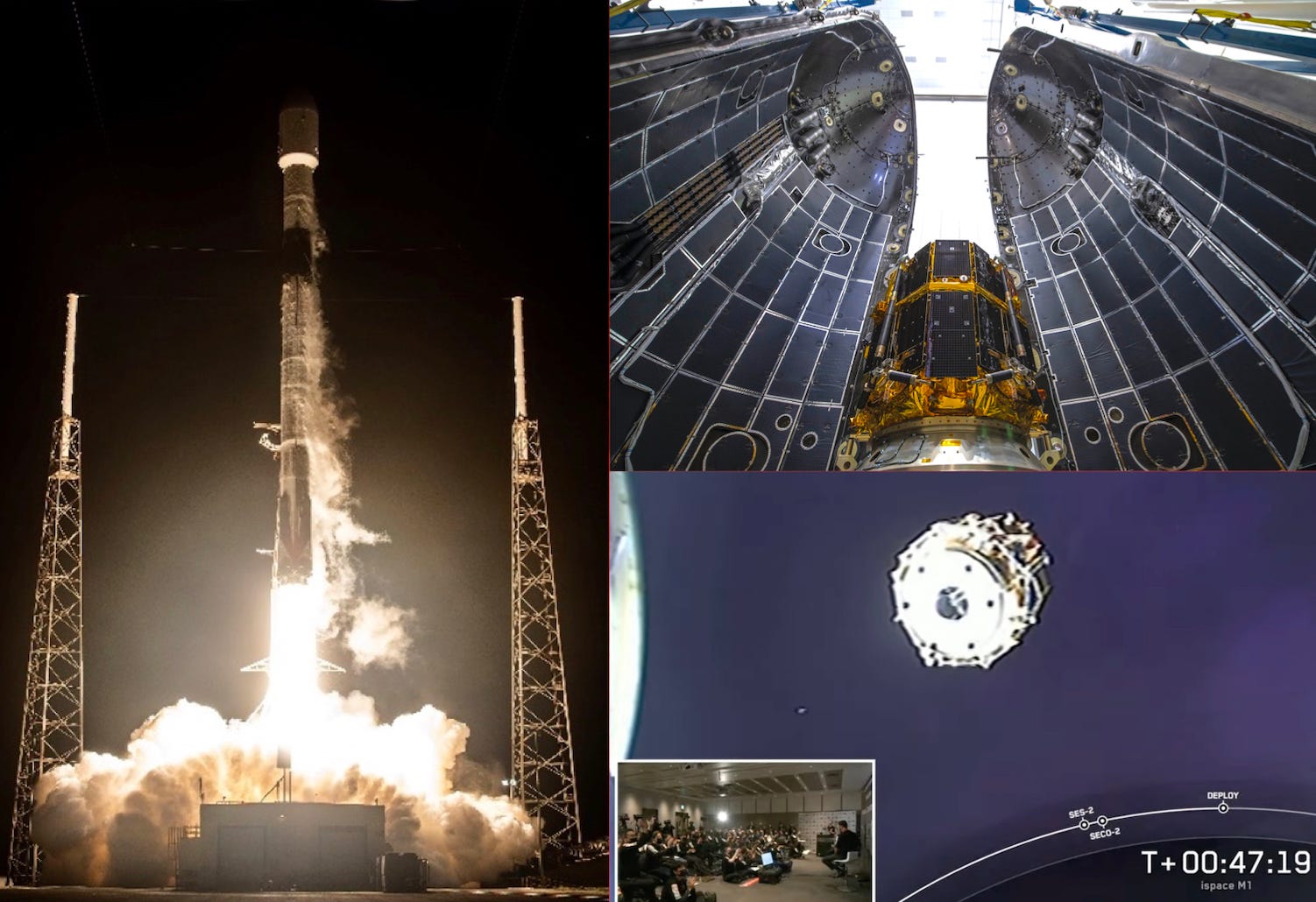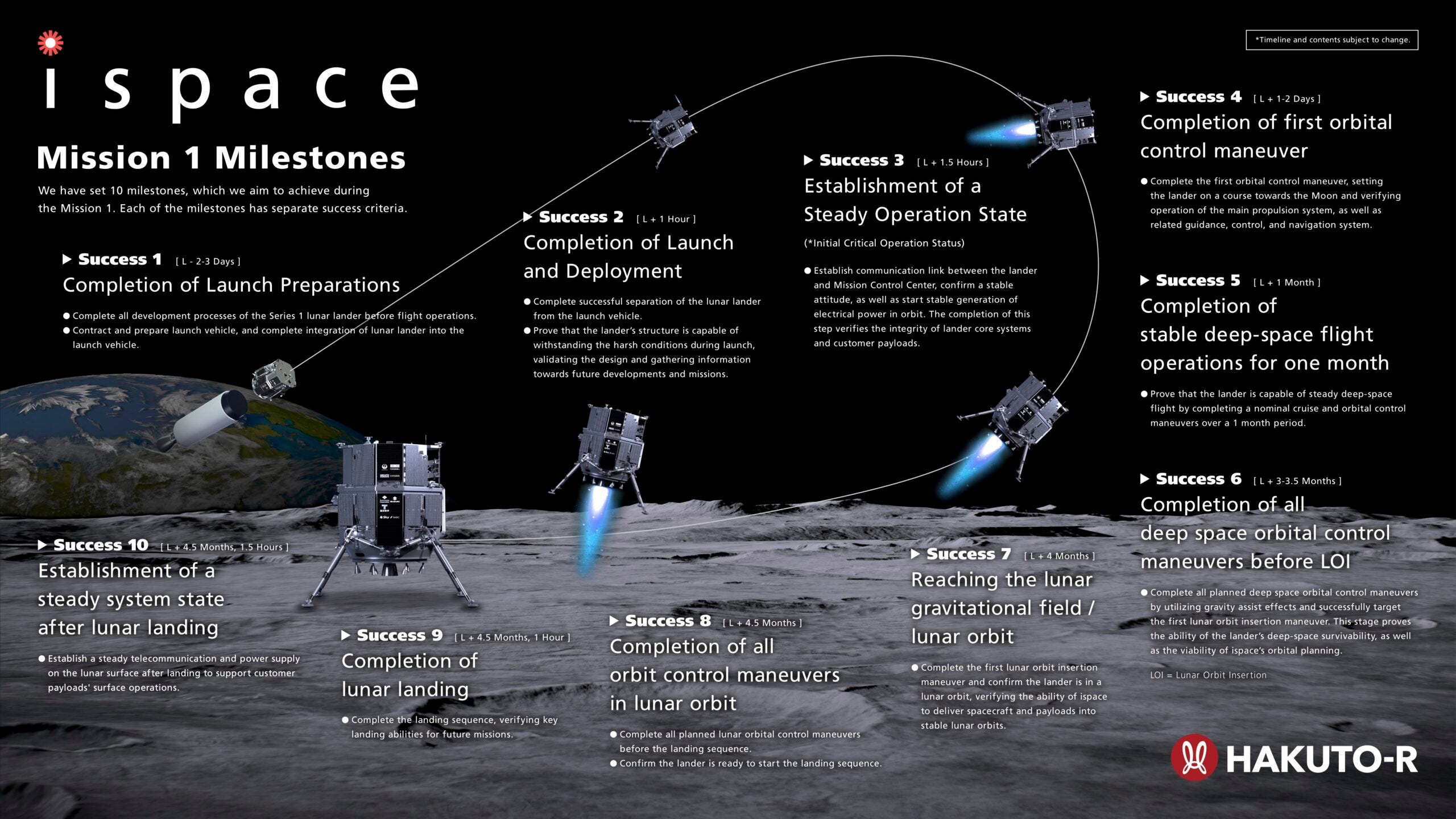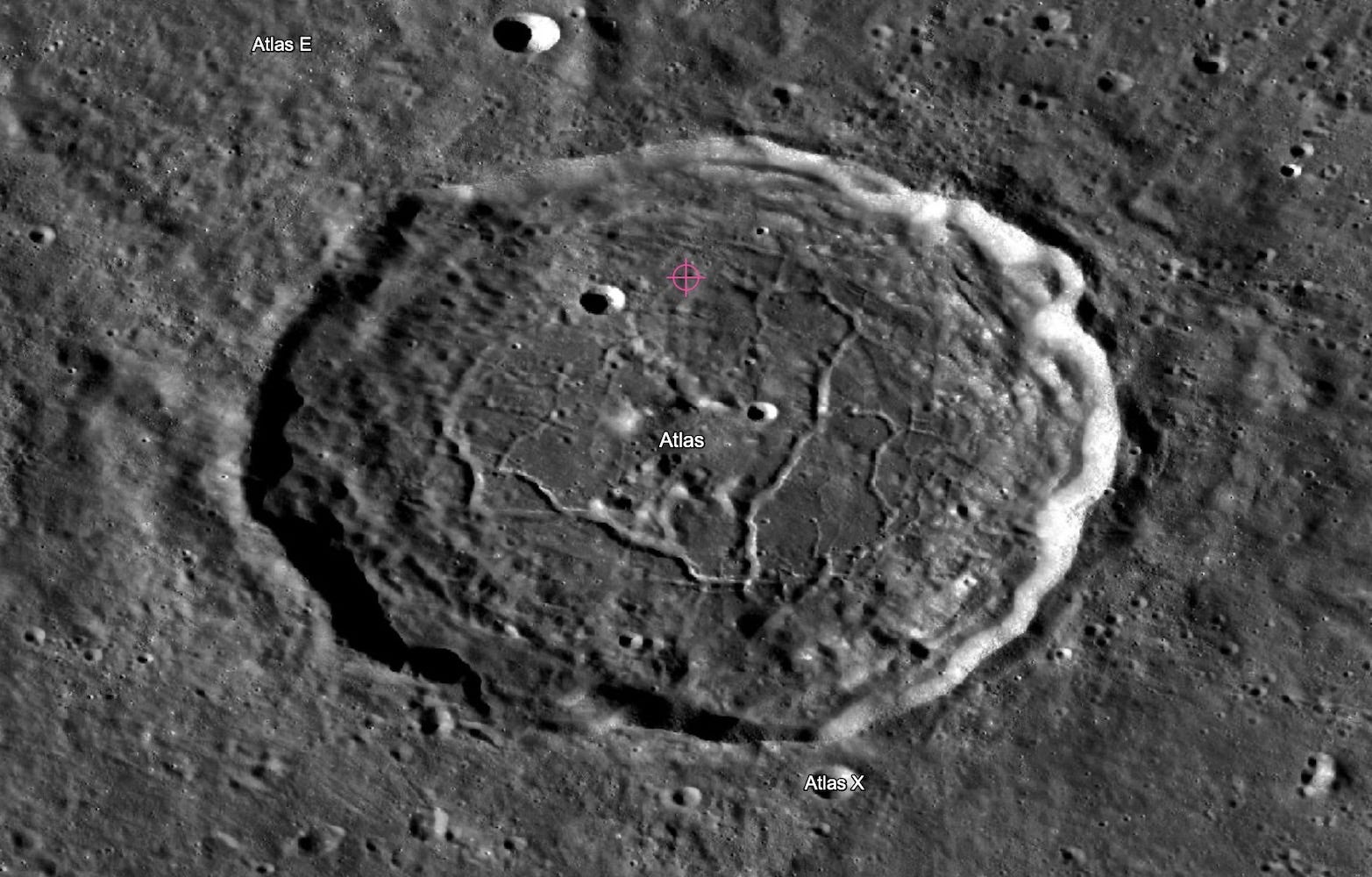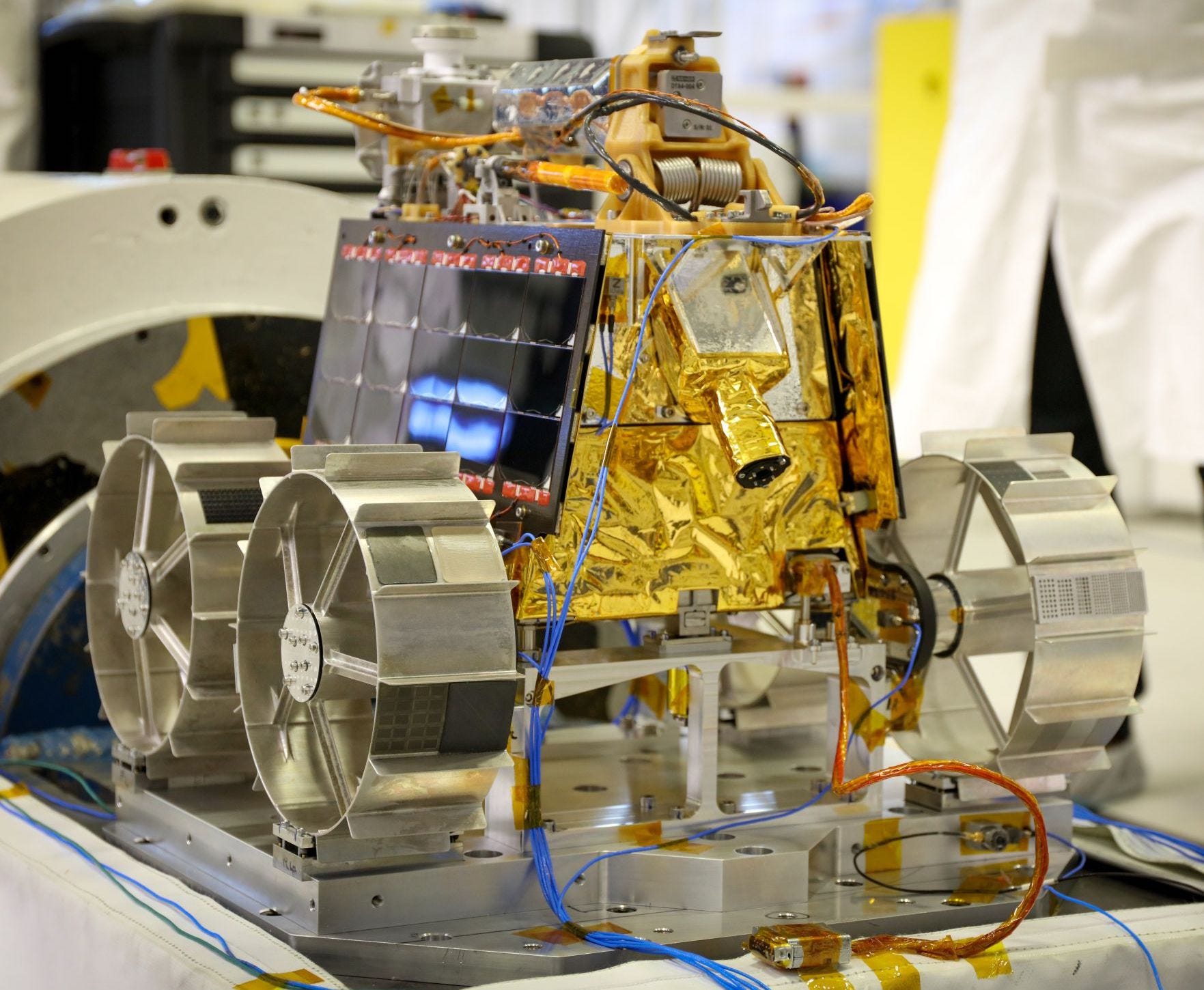ispace Japan’s lander launches for the Moon, carrying UAE’s rover and hopes for its future lunar ambitions
Edit on May 29, 2023: The lander failed to touchdown. :(
Today, December 11, private Japanese company ispace inc. launched its first ever Moon mission M1 on a SpaceX Falcon 9 rocket. ispace’s robotic “Hakuto-R” spacecraft is now on a low-energy, fuel-efficient trajectory to the Moon, after four months of which it will propel itself into lunar orbit. Subsequently, after system checkouts, the mission team will remotely command the start of an autonomous landing attempt end of April 2023 to the meticulously chosen landing site within Atlas crater, at 47.5°N, 44.4°E.
(The Falcon 9 launching ispace’s lander also lofted and deployed NASA’s polar water ice-mapping Lunar Flashlight CubeSat on a Moon-ward trajectory.)

ispace’s M1 mission is carrying the following key payloads to the Moon.
- The UAE’s Rashid rover, which sports three high-resolution cameras from the French space agency and an ESA-backed plasma sampler.
- A solid-state battery technology demonstration by NGK SPARK PLUG to test a safer, more compact power storage option for future, longer duration Moon missions.
- A 250-gram tennis-ball-sized rover led by the Japanese space agency, which after being deployed by the lander on the Moon’s surface will split in half to use its two hemispheres as wheels.
- Three imaging & navigation related payloads and services funded by the Canadian space agency under the country’s LEAP initiative. One of these involves Canadensys, which has a set of cameras on the lander to capture 360° views of the mission’s descent and landing as well as post-landing views of the lunar surface and payload deployments.

If ispace successfully lands the Hakuto-R spacecraft on the Moon, it will be the first private entity as well as the fourth organization in the world to achieve the feat. Israel-based SpaceIL’s Beresheet lunar lander unfortunately crashed during its attempt to achieve the same goal in 2019. In any case, it’s impressive already that ispace managed to raise money for the mission and bag truly varied international commercial customers, three of which directly involve national space agencies. While western coverage on commercial lunar landers has largely only highlighted NASA’s CLPS program and its vendors, ispace—which is also helping partner CLPS vendor Draper with a lunar farside mission—seems to have been underrated all this while.

The robotic Rashid rover
Once ispace’s lander deploys the UAE’s 10-kilogram Rashid rover on the Moon’s surface, the robotic micro-rover will study the local geology, dust and environment for 8–10 Earth days. ispace’s lander will act as the wireless communications link between the rover and Earth, which means the rover’s traverse paths have been primarily chosen such that they avoid losing line of sight to the lander. The Canadian company Mission Control has a $3-million AI flight computer on the lander to enable the Rashid rover to recognize geological features as it drives around.

The rover sports three high-resolution “CASPEX” cameras provided by the French space agency. It’s a smartphone-like camera adapted for space, and flown on NASA’s Perseverance Mars rover as well as on OneWeb satellites. A CASPEX pair on the rover’s mast will provide panoramic views of the Moon and aid navigation while the third camera will be rear-mounted to analyze drive tracks and infer wheel sinkage, and from it the mechanical properties of the local lunar soil. The rover is also carrying a Norwegian, ESA-backed instrument to sample the local plasma environment created from interactions of the lunar soil with sunlight and the solar wind.
Beyond instruments and payloads
ispace’s M1 mission is also notable for some of its partnerships that go beyond the traditional norm of carrying of instruments and payloads to space. The involvement of Canadian company NGC Aerospace in the mission serves as a good example. NGC has a deal with ispace to use one of the lander’s cameras to test their planetary navigation software, which would identify craters and other features during descent on the Moon to help the lander autonomously determine its position and navigate accordingly. As part of the deal, ispace will transfer several sets of mission telemetry and images to NGC, setting in motion ispace’s lunar data business ambitions.
Moreover, ispace’s lander will collect lunar soil samples from its footpad and transfer its ownership to NASA, a move by the U.S. space agency intended to set precedence for future resource use under the U.S.-led Artemis Accords. ispace Japan and its subsidiary ispace Europe were two of the four companies selected by NASA in 2020 to that effect, with each to be awarded a total of $5000 for their tokenistic yet historic demonstrations. ispace Europe’s said demonstration will be performed by its micro-rover flying on ispace Japan’s second Moon mission M2.
Future Moon missions by ispace
ispace’s M2 mission will launch in 2024, featuring the same lander design as M1 but iteratively improved based on lessons from the M1 mission. A mission highlight will be the indigenously built agile micro-rover for exploring the Moon’s surface, which will also perform the aforementioned demonstration to collect lunar soil and transfer its ownership to NASA. ispace Europe is developing the rover, aided by funding from the Luxembourg Space Agency under an ESA contract.
Israeli company Helios intends to have its (claimed) scalable technology of extracting oxygen from lunar soil to be onboard the M2 mission. Interestingly, ispace has been claiming since July 2022 that all of the M2 mission’s payload slots have been booked. But the company hasn’t yet revealed who those customers are.
The most intriguing Moon mission involving the company started development after ispace raised $46 million in August 2021, bringing their then cumulative funding to almost $200 million. The funding allowed ispace’s U.S. subsidiary to start work on a larger, more capable lunar lander called Series 2 in partnership with General Atomics and Draper. The latter company has provided ispace with guidance, navigation and control software for M1 and M2.
As it turns out, Draper pitched a lander based on the Series 2 design in a NASA-solicited CLPS bid for commercially delivering the agency-funded science and technology payloads to the Moon and won a $73 million contract. As such, Draper’s first Moon mission is now targeting landing on the Moon’s farside in 2025, a feat achieved only by China’s Chang’e 4 mission thus far. The Draper lander will carry 95 kilograms of NASA-funded scientific instruments. The landing region chosen by NASA for the mission is no less impressive—the 312 kilometers wide Schrödinger crater, a pristine destination long asked for by the global scientific community.

Later this decade, ispace’s Series 2 landers will also deploy Spanish-German startup Plus Ultra’s commercial communications and navigation satellites in lunar orbit. Such a continuous, high-speed communications relay service for hardware on and around the Moon is inspired in part by ESA’s ongoing Moonlight plans. ispace itself hopes to use Plus Ultra’s services as a communications relay for their farside lunar hardware.
A novel commercial model for planetary missions
Landing on the Moon is hard. Only three countries have accomplished this feat so far—the U.S., the Soviet Union and China. The fact that several space agencies globally, and NASA in particular via their CLPS program, are entrusting commercial companies to carry their instruments and payloads to the Moon in order to meet crucial science and technology objectives shows the growing confidence in building a commercial ecosystem around lunar exploration.
All of ispace’s Moon landing attempts and NASA’s CLPS program invert the tradition of having only custom-built planetary missions to meet specific scientific and technological goals. If enough of these missions stick the landing, it would open up frequent, periodic and more globally accessible low-cost flights to the Moon in ways never possible before for any planetary body.
A notable development on the risk end of this spectrum is that ispace secured the world’s first Lunar Insurance policy via Mitsui Sumitomo for the M1 mission. It covers several possible failures from launch through landing and even surface operations. While the insurance doesn’t cover the payloads onboard, including the Rashid rover, it’s still a great step as private companies and space agencies globally increasingly mount landing and roving missions to the Moon this decade, not without substantial risk.
→ Browse the Blog | About | Donate ♡
